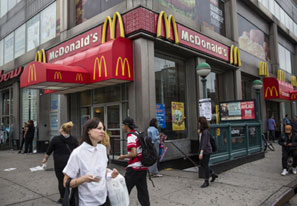
The Republican Party will win or lose the next election over economic issues, not over Donald Trump. Recently, New York governor Andrew Cuomo reminded candidates what one of those issues will be: the minimum wage. A Cuomo-controlled state board decreed a new minimum wage for fast-food workers of $15 an hour by 2020, more than twice the federal $7.25 minimum wage and 71 percent above New York’s $8.75 minimum wage. Right now, the Democrats have the rhetorical advantage on the wage issue. Who could argue with paying hard-working, mostly minority employees a little more, the argument goes—especially when the money is coming out of owners’ pockets? But if the Republican candidates delve into the details, they’ll find that the issue of wages can work for them—as long as they have the patience to explain the unintended consequences of an easy-sounding policy.
Cuomo is a smart politician, and he put himself on the popular side of a hot national cause. Yet the governor had a problem: he couldn’t get the state legislature, with one house controlled by Republicans, to agree to a drastically higher minimum wage. So he tapped into a little-known provision of state law enabling the governor to appoint a board to investigate wages in particular industries and to empower that board to recommend to the state labor commissioner a wage “sufficient to provide adequate maintenance and to protect the health of the employees.” The commissioner then can decree that minimum wage.
Last month, after three months of study, the board recommended a $15 minimum wage for fast-food workers in New York City by late 2018 (later for the rest of the state). The state labor commissioner, who works for Cuomo, will surely accept the recommendation. As Cuomo said at a rally celebrating the ruling, “You cannot support a family on $18,000 per year. . . . This is going to help hundreds of thousands of New Yorkers.”
But is it? It’s axiomatic that if you’re a fast-food worker making $9 an hour, you’ll do much better making $15. That’s a terrific outcome for those workers. But what if you can’t keep your job—or can’t get a job—at the new rate? Any hike in the minimum wage will have that effect on some workers. Last year, the Congressional Budget Office found that with a higher federal minimum wage of $10.10, “some jobs for low-wage workers would probably be eliminated, the income of most workers who became jobless would fall substantially, and the share of low-wage workers who were employed would probably fall slightly.” Nationwide, 500,000 people would lose their jobs or fail to find one, the CBO reported. At the much higher $15 rate, 6.6 million workers nationwide could lose their jobs, a new Manhattan Institute study estimates. In New York State alone, a previous study found that a smaller wage hike several years ago cost many younger workers their jobs.
How does a higher wage translate into job losses? With a $15 minimum wage in New York, fast-food companies will start to automate, substituting touch screens for the people who take orders, and even, eventually, substituting robots for the people who cook the food. The industry has the money to do this: McDonald’s alone returns $6 billion a year to shareholders; the burger giant could instead invest some of that money in technology. And the struggling fast-food industry has the motive to cut costs, too. “Guest counts” and sales are falling, because middle-class people don’t want to feed their children unhealthy food, at least not more than once or twice a year. Poorer customers, in turn, can’t afford higher prices.
Not all fast-food workers—or even most—will lose their jobs, for a while, anyway. But who will get the higher-paying fast-food jobs that remain? A low minimum wage allows fast-food franchise owners to take chances on people who’ve never held a job or on people with few skills. A higher wage raises the stakes and also encourages people with more experience and higher skills to enter the workforce, where they’ll compete with high-school drop-outs and recovering drug addicts. The single mother who needs the job most may lose an opportunity to prove herself because an ambitious college student, who might have stayed out of the labor force for $9 an hour, finds it attractive to work for $15 an hour.
Moreover, were Cuomo to apply the $15 minimum wage to other retailers, something he says he wants to do over time, we’d see even more jobs disappearing. A person can’t order a McDonald’s hamburger online. She can certainly order a pair of jeans online, as she might be inclined to do as the in-store price goes up so that the owner can pay the higher minimum wage. It’s ironic that the person whom Cuomo appointed to his wage board to represent business interests is Kevin Ryan, founder of Gilt, “an innovative online shopping destination.” Previously, he made his money selling online advertisements. Ryan knows little about the plight of struggling brick-and-mortar retailers.
Still, what to do about people who work hard but find themselves unable to get ahead? Republican presidential candidates should offer a ready answer: a higher tax credit for working adults. Right now, a single fast-food worker with two children can get back $5,000 from the government each year—the equivalent of an extra $2.50 for each hour worked. Republicans should suggest an even higher tax credit for lower-wage workers, including for adults without young children. Right now, the earned-income tax credit for adults in that category is negligible, even though many older people with grown children—as well as younger people who have put off becoming mothers or fathers until they can support children—are struggling to pay the bills. Instead of allowing some low-wage workers to benefit at the expense of other low-wage workers who lose their jobs, or who can’t find employment, we should use the tax code, in effect, to fund a higher minimum wage for all the working poor.